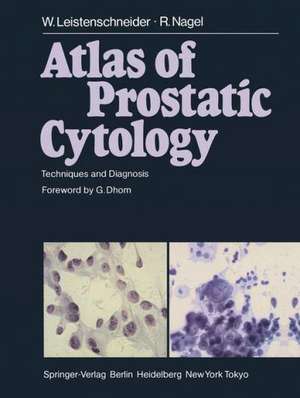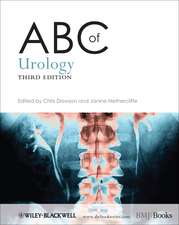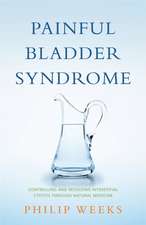Atlas of Prostatic Cytology: Techniques and Diagnosis
Autor W. Leistenschneider Cuvânt înainte de G. Dhom Traducere de R. Mills Autor R. Nagel Traducere de M. Winteren Limba Engleză Paperback – 22 noi 2011
Preț: 721.05 lei
Preț vechi: 758.99 lei
-5% Nou
Puncte Express: 1082
Preț estimativ în valută:
137.97€ • 143.77$ • 114.24£
137.97€ • 143.77$ • 114.24£
Carte tipărită la comandă
Livrare economică 03-17 aprilie
Preluare comenzi: 021 569.72.76
Specificații
ISBN-13: 9783642701122
ISBN-10: 3642701124
Pagini: 240
Ilustrații: X, 228 p.
Dimensiuni: 210 x 280 x 13 mm
Greutate: 0.55 kg
Ediția:Softcover reprint of the original 1st ed. 1985
Editura: Springer Berlin, Heidelberg
Colecția Springer
Locul publicării:Berlin, Heidelberg, Germany
ISBN-10: 3642701124
Pagini: 240
Ilustrații: X, 228 p.
Dimensiuni: 210 x 280 x 13 mm
Greutate: 0.55 kg
Ediția:Softcover reprint of the original 1st ed. 1985
Editura: Springer Berlin, Heidelberg
Colecția Springer
Locul publicării:Berlin, Heidelberg, Germany
Public țintă
ResearchCuprins
1 The Technical Bases of Aspiration Biopsy.- 1.1 Preparation and Positioning of the Patient.- 1.2 Lubricants and Anesthesia.- 1.3 Instrumentarium for Aspriation.- 1.4 Technique of Aspiration.- 1.5 Acquisition of Suitable Cellular Material.- 1.6 Macroscopic Evaluation of the Aspirate in Biopsy Smears.- 1.7 Smear Technique.- 1.8 Fixation.- 1.9 Shipment of Smears.- 1.10. Complications.- 1.11 Prophylaxis Against Infection.- 1.12 Staining Procedures.- 2 Cytological Microscopy.- 2.1 Microscope.- 2.2 Brightfield Microscopy.- 2.3 Fluorescence Microscopy.- 2.4 Guidelines for Brightfield Microscopy.- 2.5 Procedure.- 3 Normal Findings.- 3.1 Individual Cells, Sheets of Cells and Background.- 3.2 Nuclei.- 4 Atypia.- 4.1 Classification According to Papanicolaou.- 4.2 Atypical Hyperplasia.- 5 Secondary Findings.- 5.1 Erythrocytes.- 5.2 Seminal Vesicle Epithelial Cells.- 5.3 Epithelial Cells of Rectal Mucosa.- 5.4 Urothelial Cells.- 5.5 Metaplastic Squamous Epithelial Cells.- 5.6 Sheets of Keratin.- 5.7 Histiocytic Giant Cells.- 5.8 Intracytoplasmic Granules.- 6 Artefacts.- 7 Primary Diagnosis of Carcinoma.- 7.1 Procedural Reliability.- 7.2 Cytological Criteria for Prostatic Carcinoma.- 8 Grading of Prostatic Carcinoma.- 8.1 Histology.- 8.2 Cytology.- 8.3 Cytological Grading According to the Uropathological Study Group on ‘Prostatic Carcinoma’.- 9 Treatment Control by Means of Regression Grading.- 9.1 Cytological Signs of Regression.- 9.2 Cytological Regression Grading.- 9.3 Reproducibility.- 9.4 Clinical Significance of Cytological Regression Grading.- 9.5 Validity of Cytological Regression Grading.- 9.6 Signs of Regression After Initiation of Treatment.- 9.7 Cytological Regression Grading and Findings at Palpation.- 10 Sarcomas.- 11 Secondary Tumors of the Prostate.- 11.1Cytomorphological Criteria.- 12 Prostatitis.- 12.1 Classification.- 12.2 Diagnostic Reliability.- 12.3 Clinical Significance and Complications.- 12.4 General Cytological Criteria of Prostatitis.- 12.5 Summary.- 13 DNA Cytophotometry.- 13.1 Feulgen’s Reaction.- 13.2 Single-cell Scanning Cytophotometry.- 13.3 Flow-through Cytophotometry.- 13.4 New Developments in Automatic Cytodiagnosis.- 14 Results of Measurement of Nuclear DNA by Single-cell Scanning Cytophotometry in Prostatic Carcinoma.- 14.1 Well Differentiated Carcinoma (Grade I).- 14.2 Moderately Differentiated Carcinoma (Grade II).- 14.3 Undifferentiated Carcinoma (Grade III).- 14.4 Our own Results with Nuclear DNA Analysis by Single-cell Cytophotometry in Treated Prostatic Carcinoma.- 14.5 The Importance of DNA Cytophotometry in the Treatment of Prostatic Carcinoma.- References.













